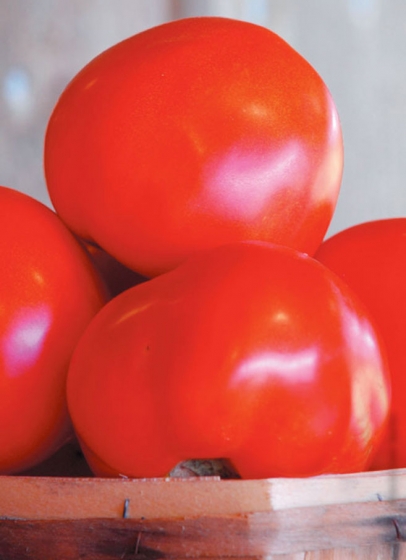Summer Tomato Gardening
Across the street at Flora Gardens nursery this spring, Tomatomania! blew out a slew of heirloom, hybrid and “garden variety” lycopersicum transplants. Take a wild guess. They were probably dealing Zebras, Cherokees, German Johnsons, Beefsteaks, Early Girls and Jubilees. Everybody came and got their ’maters!
You can forget to plant the cucumbers and eggplant, but not the tomatoes. If there is anything absolute in a summer vegetable garden, that would be the tomato.
Then comes the woe and tragedy. The fret and handwringing begins after three weeks or so, when the prizetaker is on the ropes, feebly wincing in the midday sun, no matter how much water she gets, nor weeding, feeding and prayer. Then the people come seeking the guru. I pretend to be one every tomato season. I always have my old holey garden-guru straw hat handy to be in costume and dispense wisdom with greater grandeur.
“Oh, please tell me what I’ve done wrong!” they say.
Then I start ticking off the questions: I ask them about soil, water and shade. I ask them what they had in that spot before. I ask them who’s lurking by day, say, a squirrel? I say, “Did you plant before it got kind of chilly at the end of March?”
I ask them if they’ve gone out at 1am with a flashlight to see if some horrible horde of creepy six-legged bandits is nibbling at the base. “Did you scare a bunny while you were out there?”
I ask if they think to carve around the root-zone with a knife, gentle-like, to see if some disgusting baddy is visiting the roots. Did they go away for four days, leaving their treasure in the custody of that surfsmitten, skateboard-riding, sun-scorched neighbor boy right when Rincon was pumping?
I don’t know if I will solve their problems, but at least I can care. Successful horticulture depends on the most fundamental ingredient other than water, which is the humble loam beneath your feet.
If you want your soil to work for you, you must train it from the beginning to function optimally. Your soil likes to be deep. Which means you will need to dig and turn, spade and throw, chiseling down, down to 16 inches. Soil loves sweat!
You need to get some air into the mix. Yes, air! Keep it fluffy, Buffy. And you can beef up your fluff with what they call hereabouts “decomposed matter.” Some of my friends say it doesn’t matter any more, but things must matter, or at least they should, especially if the matter is not decomposed enough.
You see, you may have hauled in some “soil” from a vendor, or had it brought to you in a beater truck, but that was not soil in the slightest. Nor was it “compost,” meaning fully decomposed, but probably a hurriedly scraped together amalgam of ground-up brush and chippings, mixed with a bit of poo, watered, turned and then shoved post haste out the gate to make way for another payday. Gina Nonini makes it out of manure from organic dairy cows in Fresno and Patty Pagaling bags it up in Ojai (marketed under the Sacred Cow label.)
Good compost looks like really good dirt. Or soil, as they say in loftier gardens. When you squish it in your palm, it should hold together, like a little crumbly ball. And if your soil’s not dry as fresh saltines, it, too, should squish.
If you brought in some wood-chippy fiddle-faddle, you’re going to have to lay in some more nitrogen. The anti-squish bark mulch is stealing your nitro! Fie, oh unnatural amendment!
Yes, Buff, more stuff. Think of it like a bad paint job. If you just hate that shade of yellow on your cucumbers you have to splash on some primer and repaint them green. For my money, I think I would just go with the steer manure. Stay away from the chicken. Chicken’s hot, smellier and kind of dubious. It’s all industrial, but the chicken is straight out of Upton Sinclair.
And I, I have to say, grew some good plants in my day using steer. Nowadays, since I am pro, and a straw-hat guru, I use certified organic soybean meal for my nitrogen. But, no, you can’t buy it anywhere. We tried. And I cannot sell any of what I have. The Commissioners may find out. Get some fresh steer.
Work it in, lightly and not all at once. Don’t overdo or you will give your garden a nitrogen hangover. Give it another dose in a few weeks. A couple handfuls around the base, scuffed in by hand, scratched in by nail. Get dirty so you will deserve those tomatoes.
Add water by the trickle, right at the base, a good long drink of it, then lay off and put some straw mulch around the plant to keep the water from becoming a cloud for somebody else’s rainstorm.
Now, back to the flashlight and the midnight creep, because your mulchy shade may have become a Best Western motel for more earwigs than anybody has seen in 21 years. Pill bugs, earwigs, snails and slugs.
It’s you versus the voracious, unrelenting wild, and you must be ready to slash and smash for your dinner. Prevent and contain! Garden like a Hopi, singing songs to remind you to be ever ready, ever faithful and dream. Dream of bowls, with tomatoes spilling out all over the table. Rolling on the floor, out the door.
Steve Sprinkel is a regular contributor to Edible Ojai & Ventura County. A longtime commercial organic farmer, he co-owns Farmer and the Cook with his wife, Olivia Chase, in Me iners Oaks.





